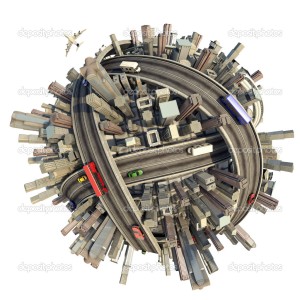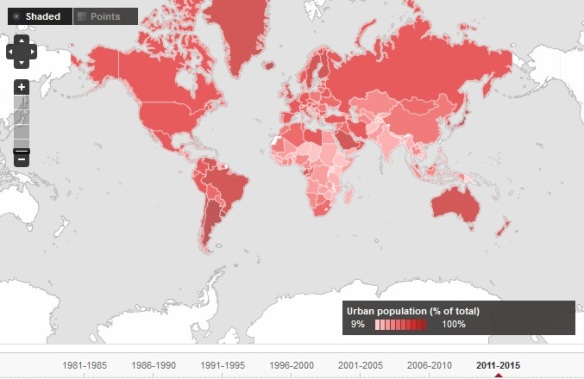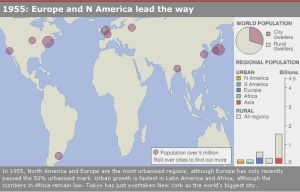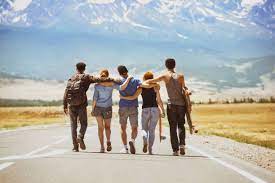
3.es.24 La primavera ya llegó.

2.en.07 Living in a City

We have learn a lot about people migrating to other countries, but is anything changing within countries as regards where people prefer to live?
In fact, it seems that more and more people are moving from rural into urban areas.
Watch the video about the situation in China https://www.youtube.com/embed/KNXg-kYk-LU?version=3&rel=1&showsearch=0&showinfo=1&iv_load_policy=1&fs=1&hl=en&autohide=2&wmode=transparent
Task 1 Answer the following questions:
1 How many people have left rural areas to seek work?
2 What were the reasons why people left rural areas?
3 What are the negative aspects of migration?
4 What has happened to the wealth gap over time?
5 What changes has Shenzhen seen since 1978?
6 How do GDP values of coastal regions compare to GDP of western countries?
Now, explore the link below to discover what is happening in rural areas:

Task 2
1 Find a definition of the following key concepts:
MEDC
LEDC
2 Write down the most significant impact of rural to urban migration for rural areas
Stories of emigration
It seems that very soon most of the world’s population will be living in urban areas. What makes them so attractive? Find out more by clicking on the image below. You’ll find some personal stories from people that have emigrated to a city. Your teacher will assign one of them and read you’ll have to his/her story.
Task 3
You need to note down:
- Name and age
- Place of origin
- Reasons to leave her / his hometown.
- Positive and negative aspects of living in a city.

Growing cities
Is urban growth similar in all countries? Does urban population grow faster in rich and developed countries? What are the causes of urban growth? Click on the image below:

Task 4. Answer the following questions:
a) find definitions for: urbanisation; life expectancy; infrastructure
b) One of the problems of fast urban development are shanty towns. What are these? Name two problems people living there must face.
c) In Curitiba – Brazil, they have solved the problem of urban growth with some sustainable measures, name two of them,
In some countries urban growth in much faster than in others. Find out by clicking in the two images below:


Now you are going to use the data from The World Bank to explore how urban population has changed in the last years:

Click on the map to see what the changes have been in the last decades:

Choose a country in each continent. What percentage of its population lives in cities?
Big urban areas have changed considerably in the last 60 years. Click on the map below and see what the changes have been:

MEGACITIES
In fact, today most people seem to prefer living in urban areas, so that some cities have grown so much that they have become bigger than some countries. We call them megacities. Find out more in the following video: https://www.youtube.com/embed/_jnMivEZ8gc?version=3&rel=1&showsearch=0&showinfo=1&iv_load_policy=1&fs=1&hl=en&autohide=2&wmode=transparent
Do you know any of these megacities? Have you ever visited one? Would you like to live in one of them?
Watch the video to learn about the fastest growing megacities: https://www.youtube.com/embed/6w93-evj-d0?version=3&rel=1&showsearch=0&showinfo=1&iv_load_policy=1&fs=1&hl=en&autohide=2&wmode=transparent
PROJECT
Now it’s your turn to explore and learn a bit more.
In small groups (3 or 4 people) teachers will assign you a Megacity.
Use the Internet to find information about:
Features
- Country (developed or developing?)
- Number of inhabitants
- Population density
- Growth in the last 30 / 20 / 10 years
- Infrastructures
- Means of public transport (in and out; within)
- Health and education facilities (hospitals, universities, …)
- Main economic sectors (factories, services, administration, …)
- Landmarks & Monuments
- Green areas: parks, gardens
- Main problems
- housing problems, pollution, lack of education or health services…
Use of the information you have gathered to create a presentation for the class.
2.ca.3 Palma, ciutat d’escultures

¿Sabíeu que la majestuosa escultura d’una dona que trobam al Passeig Marítim fou obra de Remígia Caubet i que representa Nuredduna, un personatge mitològic creat per Miquel Costa i Llobera?
Amb la SA3 coneixerem part del patrimoni escultòric de Palma i n’elaborarem una audioguia descrivint les escultures, fent-ne una possible interpretació i donant a conèixer textos literaris que tenen molt a veure amb aquestes peces; d’aquesta manera, total persona interessada en aquest aspecte cultural de la nostra ciutat podrà gaudir d’un magnífic itinerari guiat.
3.es.23 «Caminante, no hay camino, se hace camino al andar.» El CD y el CI.
3.es.22 El verbo haber.
2.es.21 EL MESTER DE CLERECÍA EN EL S. XIV: EL LIBRO DE BUEN AMOR DE JUAN RUIZ, ARCIPRESTE DE HITA.
2.es.20 El oficio del docto. Primera parte.

CONTENIDOS:
- CARACTERÍSTICAS del mester de clerecía frente al mester de juglaría.
- ETAPAS del mester de clerecía.
- PRIMERA ETAPA, S.XIII: Los milagros de nuestra señora de Gonzalo de Berceo.
2.es.17 SA 4: Mi ruta al castillo de Alaró.
2.es.18 Escribo mi entrevista.

https://www.rtve.es/play/videos/a-fondo/salvador-dali-fondo-1977/4598867/




